Imagine your eLearning course is a world-class traveler. It’s packed with valuable knowledge, but it needs the right passport to be accepted by different learning management systems (LMS) – that’s where SCORM (Sharable Content Object Reference Model) comes in. This guide will be your one-stop shop for understanding SCORM meaning, from its format and functionalities to the actionable steps of integrating your course into global LMS platforms.
As an entrepreneurial online educator, you’d like to deliver value to learners and profits to your business, right? That’s exactly the sweet point for the SCORM format to step in.
SCORM format explained
Let’s explore this analogy. Imagine that course content is a light bulb (the knowledge), SCORM is the light bulb socket (the standard format), and the LMS is the lamp (the platform). SCORM ensures the knowledge is compatible with most of the learning platforms a company might use.
The power of this symbolic light is so significant that 1% of work training equals +218% of corporate revenue (source).
At its core, SCORM course is a ZIP archive, aptly named SCORM package. This self-contained bundle houses all the necessary files, with the star of the show being the manifest file. This document, crafted in the language of XML (eXtensible Markup Language), serves as a comprehensive blueprint for the package’s contents, including the course’s structure, instructional materials, learning flow, and essential metadata.

What does it record?
SCORM isn’t the course content itself, but rather a container that ensures your course and the LMS understand each other. SCORM package records learner interactions, like when they start a module, answer a quiz question or complete a simulation. It tracks their progress, including scores and completion status, enabling robust tracking and reporting capabilities.
This detailed data allows you to see not just if learners finished your course, but how they navigated it, where they might have gotten stuck, and what topics resonated most. This information becomes invaluable for further improvement of the course content, identifying areas that need clarification, and even personalizing the learning experience for future students.

What are the versions of SCORM?
The right SCORM version acts as the bridge between valuable knowledge and a wider audience of eager learners. Which one is right for you? Depends on the LMS used and the desired tracking capabilities.
Here’s a breakdown of the two main SCORM versions you’ll encounter:
- SCORM 1.2 (Released in 2001): The veteran of the bunch, SCORM 1.2 offers basic tracking capabilities. It can record a learner’s progress through a course, including completion status and scores. However, it lacks the ability to track more granular interactions, such as when a learner revisits a specific section or struggles with a particular question type.
- SCORM 2004 (Released in 2004 with multiple editions): This more advanced version offers significant improvements in tracking functionality though comes with a steeper technical learning curve. SCORM 2004 allows you to capture detailed learner interactions, including timestamps within the course, specific answer choices selected in quizzes, and even how learners navigate through the material. It also introduces the Sequencing and Navigation (SN) spec, enabling more complex sequencing rules and conditional branching scenarios. This allows for adaptive learning experiences based on learner performance.
The most popular LMS, used by Pennsylvania State University (Canvas), UNICEF (Moodle), and Netflix (Docebo), are compliant with both versions.
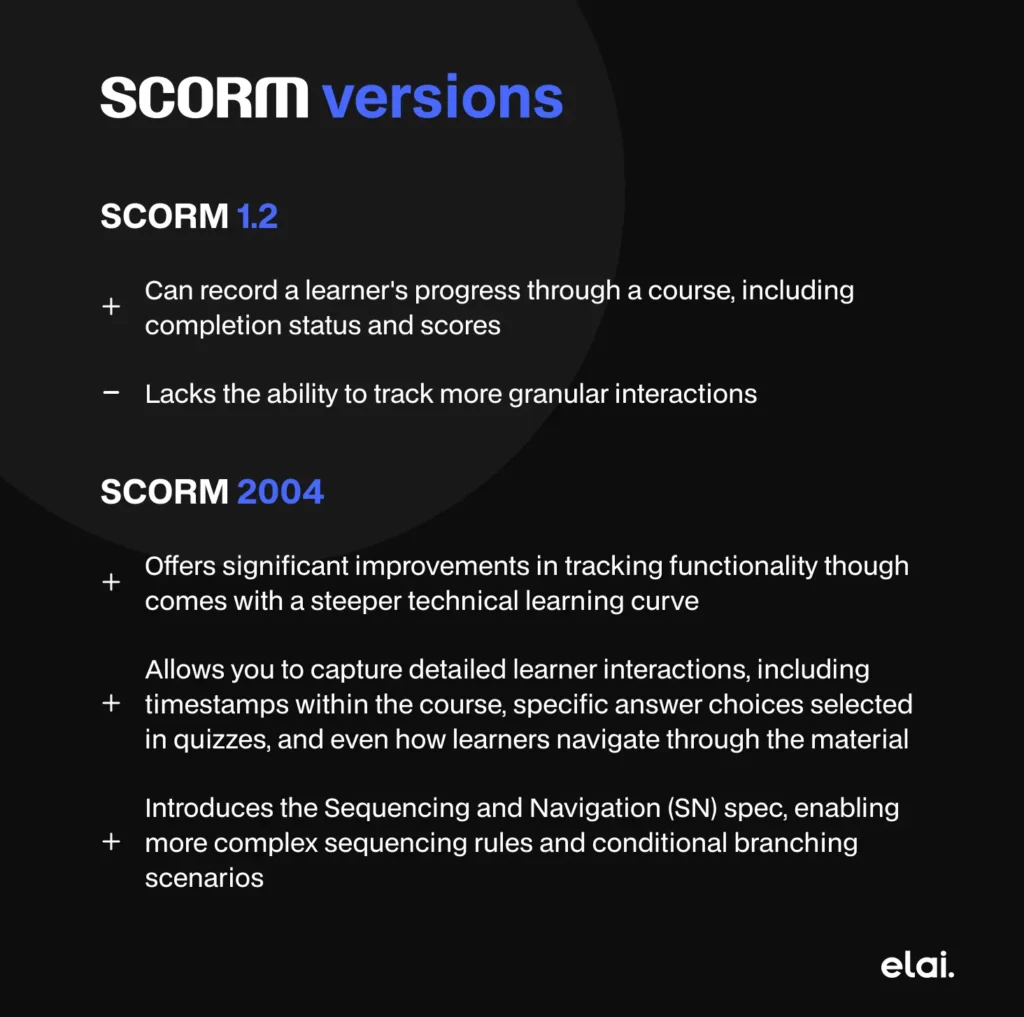
SCORM vs other formats (vs xApi, cmi5, and AICC)
In the dynamic world of eLearning standards, understanding the differences between SCORM and newer formats like xAPI (Experience API), cmi5, and AICC can be crucial for organizations seeking to optimize their digital learning experiences. To delve into nuances, let’s go back in time to 1988. Or rather, fly, since the history goes back to the aviation industry.
AICC – the old big brother
The Aviation Industry Computer-Based Training Committee (AICC) was an early standard that played a significant role in shaping eLearning practices within aviation. Its main focus was interoperability and content exchange between different training systems. AICC standards defined communication protocols and guidelines for courseware development and delivery, ensuring compatibility across various training platforms used by airlines and aviation organizations.
However, with the evolution of eLearning technologies and the emergence of more versatile standards like SCORM and xAPI, AICC has seen declining adoption outside of the aviation sector. While AICC remains a part of eLearning history and continues to be used in certain niche applications within aviation training, its influence has waned as organizations increasingly seek standards that offer greater flexibility and scalability.
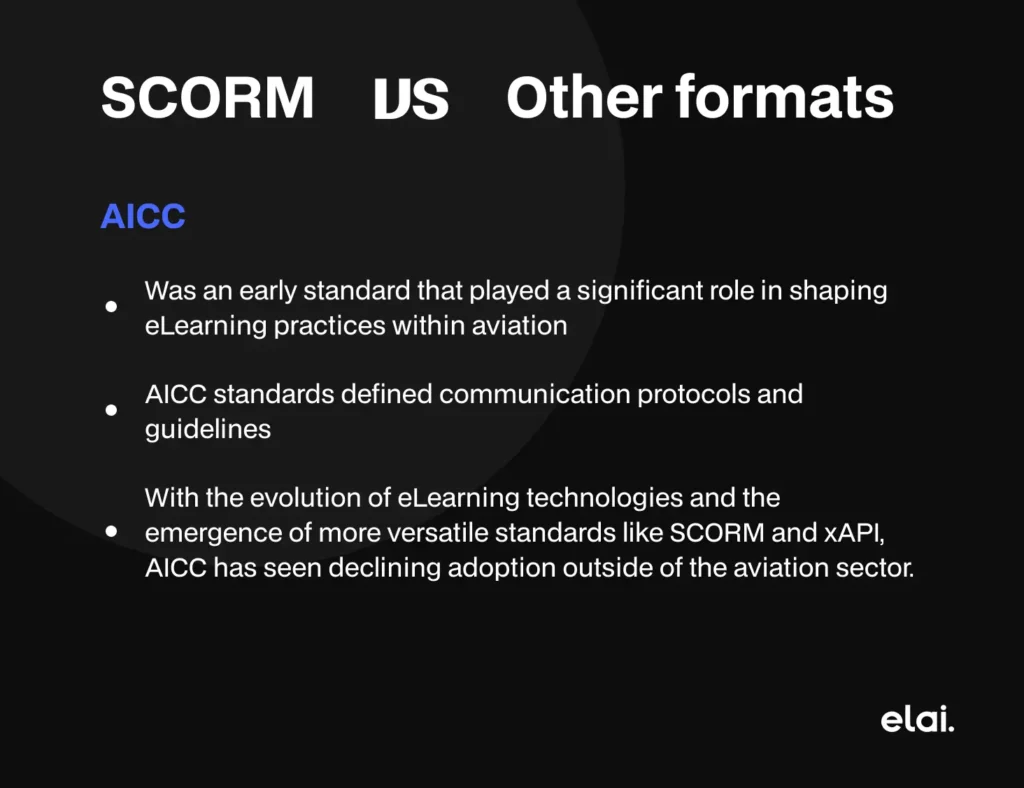
xAPI – adventurous younger sibling
On the other hand, xAPI, also known as Experience API or Tin Can API, comes across as the tech-savvy gen-z of e-learning formats. It captures learning interactions as statements in a flexible “Actor-Verb-Object” format (e.g., “John completed a simulation”). This flexibility allows organizations to gather comprehensive data on learner behaviors and experiences during mobile learning, simulations, virtual reality, games, and even offline interactions.
However, its key challenge is the complexity of implementing and managing within existing learning ecosystems. Unlike SCORM, which has well-defined specifications and established practices, xAPI requires a deeper understanding of data structures, statement syntax, and API integration. This complexity can increase development time and costs, especially for organizations with limited technical expertise or resources.
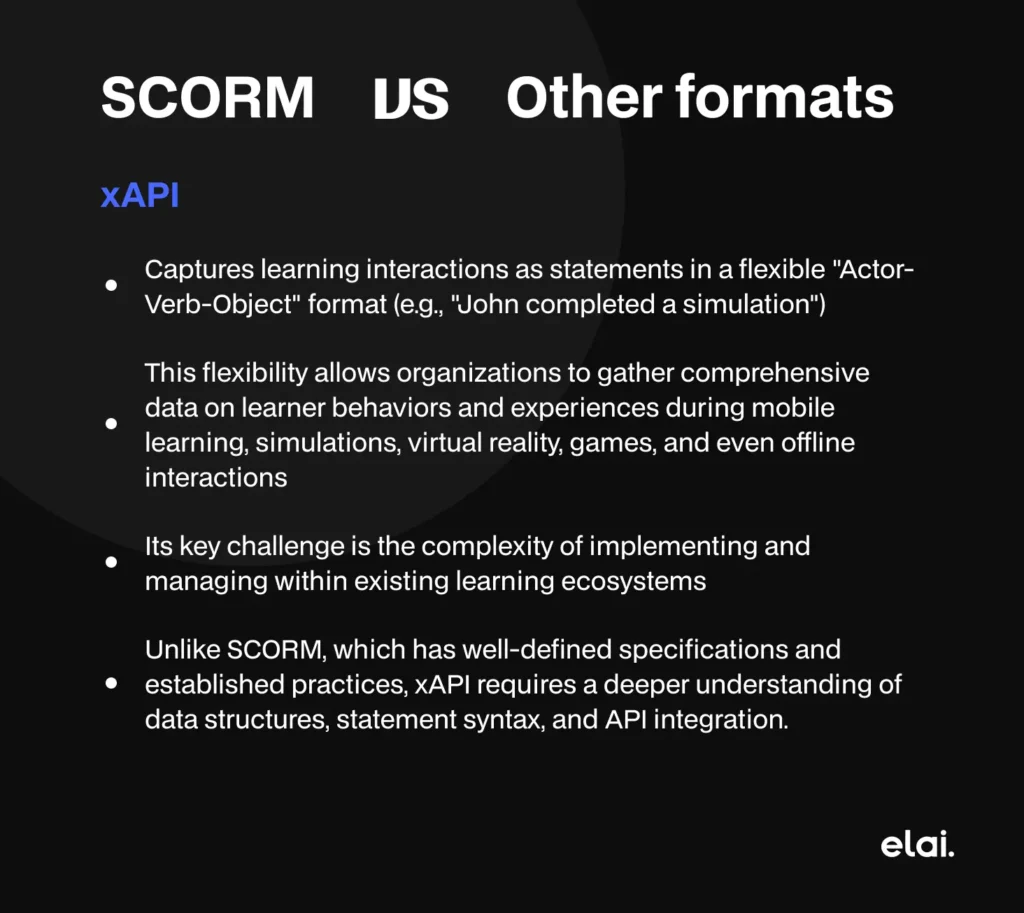
cmi5 – that innovative family
member who always makes peace
cmi5 (Competency Model and Interoperability) a bridge spanning the river between traditional SCORM and modern xAPI, offering a path forward for eLearning standards. And the path forward is rarely smooth. Organizations accustomed to the linear, course-centric approach of SCORM standard often face hurdles in adapting to cmi5’s competency-based model and support for complex learning interactions. This transition requires investment in updating authoring tools, learning management systems (LMS), and upskilling their teams to fully capitalize on the potential benefits of this innovative eLearning standard.
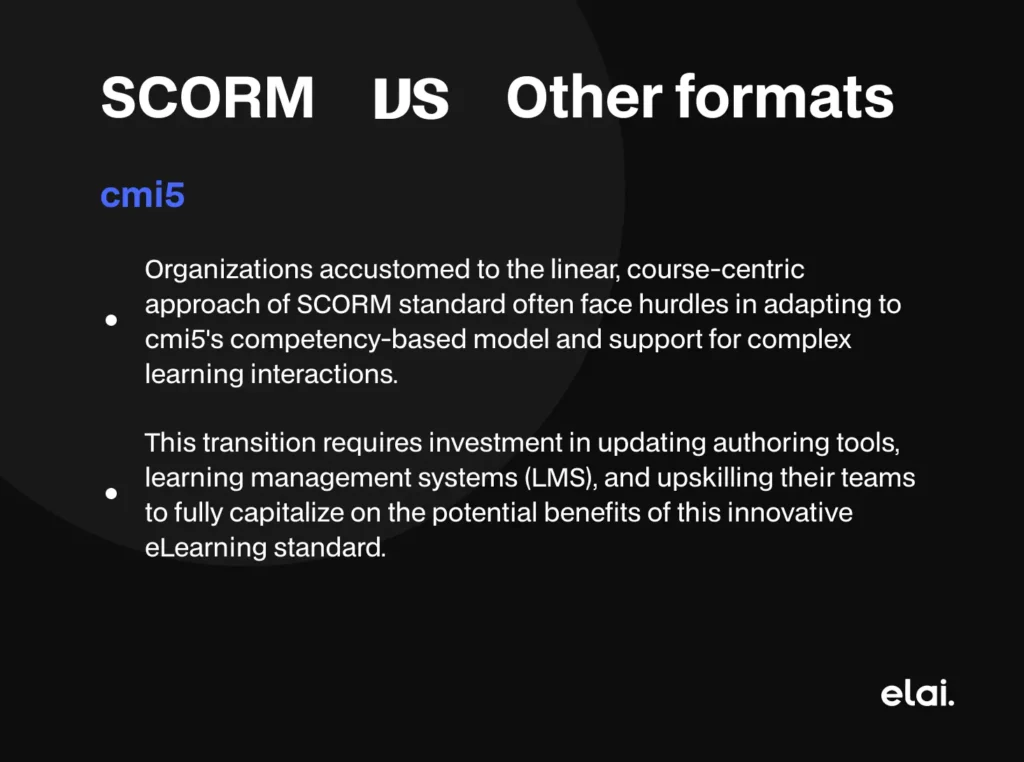
How to export videos in SCORM format at Elai (+ upload to your LMS)
Are you already looking for the contacts of trusted developers to get you through the setup process? Take a moment to read our instructions first and discover the cost-effective DIY way.
1. Prepare Your Video Content: Utilize SCORM compliant authoring tools like Elai to create your learning video content in a SCORM-compliant format. Elai offers features that allow you to generate, organize, and embed multimedia content, including videos, within your courses.

2. Export the SCORM Training: Once your video content is ready, go to the “Videos” Section and click “Preview”. Then choose the “Download” icon near the “Download” button to export the course as a SCORM package (typically a .zip file). This package contains all the necessary files and metadata required for LMS compatibility.
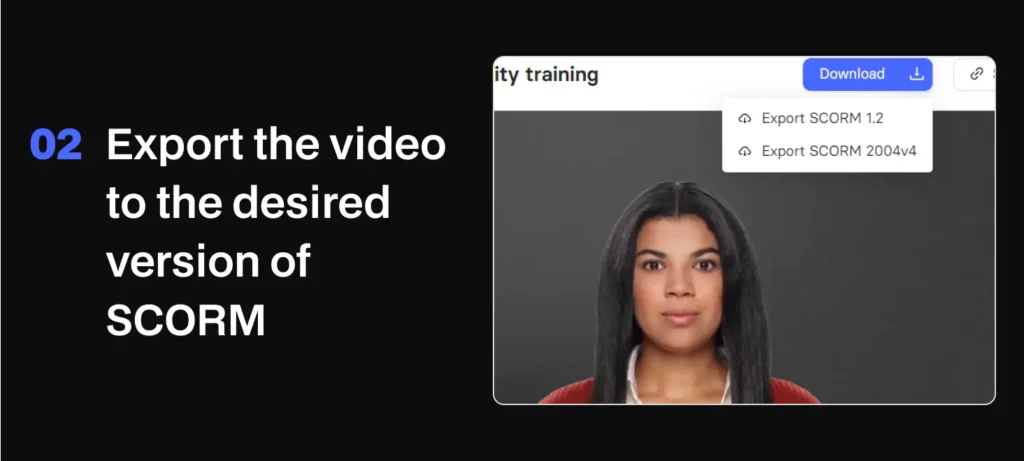
3. Upload to Your LMS (Learning Management System): Access your LMS platform where you want to deploy the course. With Elai, you’re free to choose from many options. Prioritizing workplace learning? Articulate 360 can be your go-to. Are you an active representative of the creator economy? Thinkifik helps you sell while educating. Finally, there are the famous Udemy and Moodle for academic purposes. All of these LMS are part of the Elai integrations which means you’re a few clicks away from automated and customized video creation workflow.
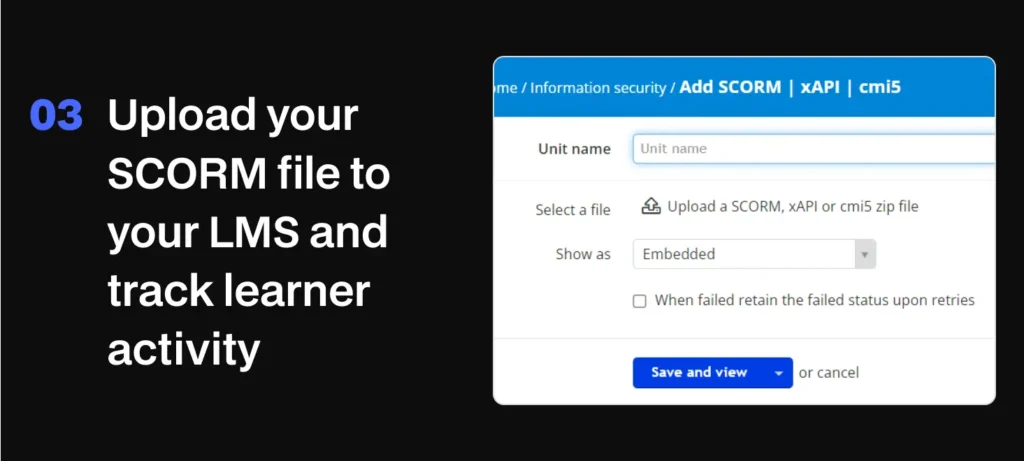
4. Navigate to the course management area and select the option to upload or import a new course package.
Next, just follow the prompts to import and configure SCORM settings within your LMS to track learner interactions effectively, including completion criteria and passing scores.
FAQ
Is SCORM only an eLearning format?
Now that you know what is SCORM, you’re also aware that it is not the only eLearning format. Though, it is the most widely adopted one. It ensures your course works on most Learning Management Systems (LMS) platforms, offering compatibility and basic tracking features like completion and scores.
There are other options, each with its strengths:
- AICC (Aviation Industry Computer-Based Training Committee): an older format with limited compatibility and tracking capabilities.
- xAPI (Experience API): captures very detailed learner data but requires a more technical setup and a separate data storage system.
- cmi5: a promising new format aiming to offer richer tracking than SCORM with a simpler setup than xAPI.
The best format depends on your needs. SCORM offers a good balance for most scenarios. If you need super detailed data, explore xAPI, but be prepared for extra work. Cmi5 shows promise but is still evolving.
Can I convert my course to SCORM format myself?
Yes, you can convert your course to SCORM format yourself, provided that you have access to the necessary tools and resources. To convert your course to SCORM file, you will typically need an authoring tool or software like Elai that supports SCORM export.
For complex courses with advanced features like simulations, branching scenarios, or interactions with external tools, a developer to ensure a smooth SCORM conversion and successful LMS integration might be required.
What are the authorizing tools supporting SCORM export?
Is SCORM an authoring tool? No, at least, not in and of itself. There are several authoring tools available that support SCORM export, allowing you to create eLearning content and package it in a format compatible with most Learning Management Systems platforms.
The widely used tools include but are not limited to Articulate Storyline, Adobe Captivate, and Lectora Inspire. Most of them are presentations-based and don’t offer avatar-based videos like Elai. Still, many authoring tool vendors offer free trials or demos, allowing you to test-drive their features and SCORM export capabilities before committing.
How do I know if my LMS supports SCORM?
First you need to know “what is scorm compliant”. The term refers to software or content that adheres to the technical specifications and ensures that eLearning content and systems can work seamlessly together.
Most LMS platforms have detailed documentation readily available online or within the platform itself. Look for sections related to “eLearning content,” “course upload,” or “technical specifications.”
These sections should explicitly mention SCORM support (versions 1.2 or 2004) or reference xAPI compatibility (a more recent standard). If you’re unsure after reviewing the documentation, don’t hesitate to reach out to your LMS provider’s support team.
Extra tip: look for SCORM Logos on their websites or marketing materials or try searching for keywords like “SCORM” or “eLearning content import” within your LMS to see if any relevant information or support articles related to SCORM compatibility appear.
